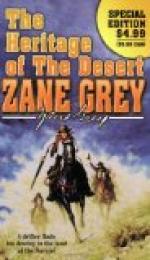As the days passed Hare learned many other things. For a while illness confined him to his bed on the porch. At night he lay listening to the roar of the river, and watching the stars. Twice he heard a distant crash and rumble, heavy as thunder, and he knew that somewhere along the cliffs avalanches were slipping. By day he watched the cotton snow down upon him, and listened to the many birds, and waited for the merry show at recess-time. After a short time the children grew less shy and came readily to him. They were the most wholesome children he had ever known. Hare wondered about it, and decided it was not so much Mormon teaching as isolation from the world. These children had never been out of their cliff-walled home, and civilization was for them as if it were not. He told them stories, and after school hours they would race to him and climb on his bed, and beg for more.
He exhausted his supply of fairy-stories and animal stories; and had begun to tell about the places and cities which he had visited when the eager-eyed children were peremptorily called within by Mother Mary. This pained him and he was at a loss to understand it. Enlightenment came, however, in the way of an argument between Naab and Mother Mary which he overheard. The elder wife said that the stranger was welcome to the children, but she insisted that they hear nothing of the outside world, and that they be kept to the teachings of the Mormon geography—which made all the world outside Utah an untrodden wilderness. August Naab did not hold to the letter of the Mormon law; he argued that if the children could not be raised as Mormons with a full knowledge of the world, they would only be lost in the end to the Church.




